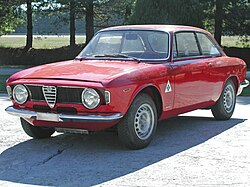Alfa Romeo GTA
| Alfa Romeo | |
|---|---|
|
Alfa Romeo Giulia Sprint GTA
|
|
| GTA | |
| Production period: | 1965-1975 |
| Class : | Sports car |
| Body versions : | coupe |
| Engines: |
Petrol engines : 1.3–2.0 liters (71–162 kW) |
| Length: | 4080 mm |
| Width: | 1580 mm |
| Height: | 1310 mm |
| Wheelbase : | 2350 mm |
| Empty weight : | 795 kg |
| Previous model | Alfa Romeo GTA 1300 |
| successor | ( Alfa Romeo 156 GTA ) |
The Alfa Romeo GTA is a sports car that Alfa Romeo built from 1965 to 1975 in the versions Alfa Romeo Giulia Sprint GTA and Alfa Romeo GTA 1300 Junior . It is based on the production model Giulia GT . Just over 1000 pieces were produced mainly for sporting use. The abbreviation GTA, which the manufacturer has used several times throughout history, stands for Gran Turismo Alleggerita . Alleggerita means "relieved". That means consistent lightweight construction with the aim of achieving success in touring car racing . By using aluminum alloys and a spartan interior design, around 200 to 745 kg empty weight could be saved compared to the series . The visible body panels were made from Peraluman and attached to the steel substructure with rivets; These rivets are clearly visible in vehicles that have been preserved true to the original, for example along the roof edges behind the rain gutters. The GTA was manufactured by Autodelta , the company responsible for motorsport . Also in the vehicle papers was the manufacturer name Autodelta and not Alfa Romeo. Special customer requests were met at an additional cost.
GTA
The four-cylinder in - line engine with a displacement of 1570 cm³ developed 115 hp at 6000 rpm. In the racing trim, between 160 and 170 hp were possible, the naturally aspirated engine did not allow more . Two double carburettors , two overhead camshafts ( DOHC ) and double ignition (two spark plugs per cylinder) were among the technical features of every GTA.
Compared to the production vehicles of the Giulia GT series, the GTA showed considerable deviations on the chassis side. In addition to the rims made of a magnesium alloy , design changes were also made:
Since a significant lowering of the vehicles was essential for racing, the camber on the front axle changed very strongly towards negative. In order to compensate for this, ball joints were changed compared to the series vehicle , which led the front wheels again with a less negative camber. To save weight, the reaction triangle on the rear axle for guiding the rear axle was made of aluminum instead of cast iron, and the trailing arms were heavily perforated.
Due to the high roll center on the rear axle due to the reaction triangle, the GTA tended to lift the front wheel on the inside of the curve, which can be clearly seen in numerous pictures. To reduce this effect, Autodelta developed a sliding block rear axle for the vehicles used there. With this, the transverse guidance of the rear axle is no longer guaranteed by the reaction triangle, but by a rearward-facing bolt attached to the differential housing, which slides in a vertical guide rail, which is supported by extensive struts against the body floor. This lowered the roll center of the rear axle and reduced the tendency for the front wheel to lift. However, this construction extremely restricts the ground clearance, which is why it is unsuitable for road use. In addition, the design generates very loud noises because every movement of the rear axle is acoustically communicated. The typical clacking and beating noises could be heard well during racing and drowned out even the very loud engine noise on bumpy tracks.
GTA Junior
In 1968 the program was expanded to include the GTA Junior with a 1300 cc engine (96 hp) at a slightly lower price. The junior was very successful in his class for years despite strong competition. In the racing version, Autodelta enabled 180 hp from the small engine. More than half of the 493 GTA Junior produced were racing versions.
GTA SA
From 1967 there were also a few supercharged vehicles under the designation GTA SA with up to 220 hp, whereby the engine was charged via two superchargers driven by oil pressure. The loaders received the necessary volume flow from an oversized oil pump driven by the crankshaft. Due to this technical solution, the power output was far lower than that of the exhaust gas turbochargers that were later widely used.
Since these vehicles were also subject to the displacement penalty customary in racing for vehicles with supercharged engines (factor 1.4), they had to start in the two-liter class. There they proved to be without a chance and were therefore without exception upgraded to "normal" GTA. Consumption was also a problem; the GTA SA are said to have required up to 90 l / 100 km in racing.
GT Am
At the beginning of the 1970s, a vehicle with a larger displacement and with an injection system had to be found for racing purposes in order to still be able to achieve success against, for example, the Ford Escort BDA or BMW 2002. That is why a racing version was derived with the appearance of the 1750/2000 GT Veloce . The choice fell on the US version of these vehicles, as they were factory-fitted with mechanical Spica injection (SPICA: Società Pompe Iniezione Cassani & Affini ).
There are different theories about the origin of the name "GT Am". Carlo Chiti , who was in charge at Autodelta at the time, said in an interview that the new vehicles GT Am are written (with spaces) and the "Am" stands for "America" because the basis was the US version. The official homologation papers for motorsport also identify the model as GT Am (written separately) "Sprint GT US Version". This interpretation is also supported by other Autodelta employees. However, at the time it was often claimed in the press that the vehicles were called GTAm (written together) and that the “m” stood for “maggiorata” or “modificata”, without this representation being ever contradicted by Alfa Romeo. To this day there is still uncertainty about the origin of the name.
Instead of the lightweight construction, sheet steel was used again for the GT Am. The mixture was prepared by a Spica or a Lucas injection system. At around 900 kg, the GT Am was a little heavier than its predecessor, which meant that it was not quite as successful in racing, although the power-to-weight ratio was significantly improved and was on par with the competition. A total of about 40 GT Am were produced. The engine of the GT Am differs considerably from the later two-liter series engine. With the GT Am, the hole spacing in the block was taken from the 1600 engine, which is why the four liners had to be manufactured in one piece because there was not enough space for separate liners between the paired cylinders 1 and 2 or 3 and 4. In addition, the GT Am had a cylinder head with a significantly smaller valve angle (46 instead of 80 degrees) than the smaller engines. This head served as a template for the later Twin Spark series engine, but differs from it in the cylinder spacing.
Sporting successes
Right from the start, the GTA proved to be superior in motorsport. In 1966 alone, GTAs achieved over 300 victories. They won the European Touring Car Championships in 1967, 1969, 1970, 1971, 1972, 1978 and 1979. The Alfa Romeo GTA was extremely successful in motorsport for around a decade. Furthermore, over two dozen national championships and many other titles were part of the success story of this extraordinary vehicle. His pilots included a. Andrea de Adamich , Jochen Rindt , Ignazio Giunti and Nanni Galli , in Germany a. a. Jochen Mass , Harald Ertl and Gerhard Schüler ( Dorian Gray discotheque , Frankfurt am Main.). The Alfa GTA was an important image carrier for the brand, and its effect continues to this day.
In 2002 Alfa Romeo revived the tradition with the Alfa 156 GTA , which was followed in 2003 by the Alfa 147 GTA . However, these model variants are no lighter than others.
Technical specifications
| technology | Giulia Sprint GTA | Giulia Sprint GTA (racing version) | Giulia GTA 1300 Junior | Giulia GTA 1300 Junior (racing version) | GTA SA | GT Am |
|---|---|---|---|---|---|---|
| Engine: | In-line four-cylinder | |||||
| Displacement: | 1570 cc | 1570 cc | 1290 cc | 1290 cc | 1570 cc | 1985 cc |
| Bore × stroke: | 78 × 82 mm | 78 × 82 mm | 78 × 67.5 mm | 78 × 67.5 mm | 78 × 82 mm | 84.5 x 88.5 mm |
| Power: | 115 hp | 164 hp | 96 hp | 180 hp | 220 hp | 240 hp |
| at 1 / min: | 6000 | 7800 | 6000 | 9300 | 7800 | 7500 |
| Compression: | 9.7: 1 | 10.5: 1 | 9.7: 1 | 11.0: 1 | 10.5: 1 | 11.0: 1 |
| Valves per cylinder: | 2 | 2 | 2 | 4th | 2 | 2 |
| Valve control: | two overhead camshafts | |||||
| Transmission: | 5 speed transmission | |||||
| Brakes: | Disc brakes front and rear | |||||
| Front chassis: | Independent suspension on wishbones with coil springs and stabilizers | |||||
| Rear landing gear: | Rigid axle guided by trailing arms with coil springs, reaction triangle | |||||
| Body: | two-door made of pereraluminum | two doors made of steel | ||||
| Weight: | 820 kg | 760 kg | 920 kg | 760 kg | 920 kg | |
| Top speed: | 185 km / h | 220 km / h | 175 km / h | 210 km / h | 240 km / h | 230 km / h |
| Construction time: | 1965-1969 | 1965-1969 | 1968-1975 | 1968-1975 | 1967-1968 | 1970-1971 |
| Number of pieces: | 500 | 193 | 300 | 10 | 40 | |
swell
- ↑ alfabb.com, Christine Becker: Oil pressure-driven chargers on a GTA-SA , Figures 8, 9 and 10, accessed on Apr 14, 2011.
- ^ Brizio Pignacca, Gaetano Derosa: ALFA ROMEO GIULIA GT. Nada Editore, Milano 2007, ISBN 978-88-7911-427-1 .
- ^ Brizio Pignacca, Gaetano Derosa: ALFA ROMEO GIULIA GT. Nada Editore, Milano 2007, ISBN 978-88-7911-427-1 .
- ↑ Julien Lombard: Giulia GT Coupe Bertone. Heel, Königswinter 2006, ISBN 3-89880-648-0 , pp. 118-120.
- ↑ Alfa Romeo Yearbook No. 5. Heel, Königswinter 2004, ISBN 3-89880-348-1 , p. 27.



